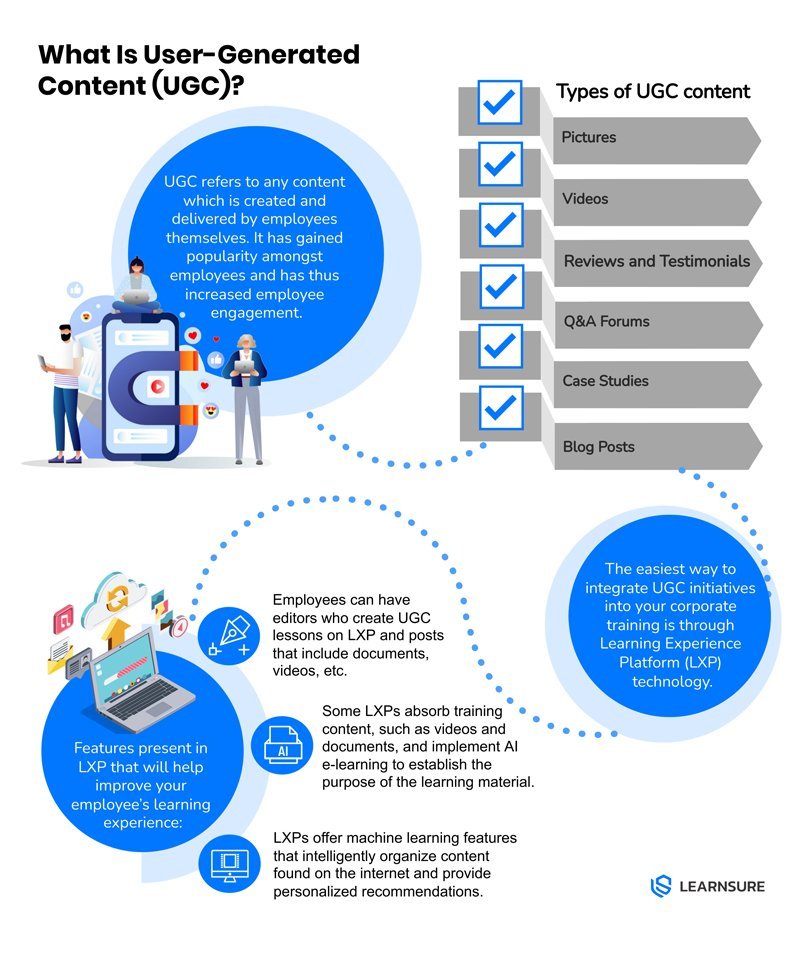User-generated content for better learning outcomes
Keeping learners engaged is not an easy job. Companies are deploying innovative strategies like user-generated content (UGC) to encourage employees to use their knowledge and share it with other team members. A lot of data supports that UGC is a powerful business tool that can help your company grow faster than ever. By applying UGC, the companies can gain the trust of their employees and ramp up their learning and development efforts.
In this article, we’ll discuss user-generated content and how it can help you polish your employee training and development strategies.

What is user-generated content?
UGC has become a major part of the digital business world. In workplace terms, the term refers to any content (photographs, videos, reviews, etc.) created and delivered by employees themselves. It has become extremely popular because it powers activity and engagement in employees who wouldn’t participate otherwise. It provides your team members with the opportunity to be more immersed in the production of content influencing the product or service your business specializes in.
This type of organization allows for equal participation. Other than that, your employees can contribute to the conversation about various projects without requiring managers to lead the way. As a result, UGC is an excellent way to elicit more creativity from your employees by promoting their input.
Why Is User-Generated Content Important for Your Business?
By setting up a training process revolving around UGC, you can expect better learning outcomes. Since it exposes participants to environments similar to the digital content consumed outside of work, they’ll absorb the knowledge shared by other participants more readily.
The UGC works because it naturally draws people to visual content. It makes the learning process more immersive, which is why you should stop pushing your content. Instead, give your team members the chance to create content themselves. Over time, they’ll eagerly structure their training by formulating plans, resulting in learners who want to make their training activities as fruitful as possible.
Another advantage of employing UGC is the knowledge sharing that occurs in every session. It allows you to include the most successful people within your business instead of those from external organizations. More experienced team members can share their knowledge and expertise with the rest, allowing for personalized learning. Once everyone has been presented with the best practices in your line of business, they’ll want to replicate those actions to improve themselves.
All of this combined builds close bonds in your community. Moreover, it engages participants to a much greater extent than ready-made content published by third parties.
How Do You Apply UGC to the Workplace?
The easiest way to integrate UGC initiatives into your corporate training is through LXP technology. It consists of many features that will improve your employees’ learning experience:
Content Creation
LXPs support user-generated content produced by end-users. Your employees can have editors who create lessons and posts that include documents, videos, images, and hyperlinks. Other users can leave comments and ratings on the lessons and posts.
AI-Driven Training and Recommendations
Some LXPs absorb training content, such as videos and documents, and implement AI e-learning to establish the purpose of the learning material. In turn, AI can trigger microlearning, recommendations, and training. In some cases, LXPs can perceive individual instructional needs and skip to a certain point in a video to find the perfect starting point for a given learner.
Content Curation
LXPs offer machine learning features that intelligently organize content found on the internet and provide personalized recommendations. Additionally, learners can manually collect third-party and internal content and share it with their peers.
Why Is LXP Technology Beneficial?
We’ve already mentioned some of the advantages of LXP learning, and here’s the summary:
Tailored Learning paths
LXPs guide your team members’ learning paths with personalized recommendations. As a result, your employees may have more to gain from the platform arising out of interactions and content directed at various learning goals. Moreover, administrators can manually configure recommendations to fit each user.
Agile Learning
Unlike traditional learning methods that require upfront planning, LXPs allow you to set up learning activities on-the-spot. This ensures an agile learning experience since the content is delivered flexibly and quickly in the natural workflow. There’s also the possibility to add microlearning content to solve particular needs, making it easier to accomplish learning goals under a busy schedule.
What Will Future Learning Look Like?
If you embrace UGC and other creative learning methods, such as design thinking, you’ll fully prepare your company It will require you to base your training activities according to employee needs and ensure engagement, participation, and opportunities to acquire new skills and ideas. Cutting-edge technology and LXPs enable you to achieve this goal in a time-saving and efficient manner.
A significant part of future workplace training will have to do with social learning. It’s a concept where employees learn by observing other peoples’ behaviours and their outcomes. At the end of the process, good forms of behaviour are promoted, whereas the bad ones are dispensed with.
As opposed to conventional methods that have a lower retention rate, social learning is much more efficient. Nowadays, people take to traits and things that they can retain more easily for having used them to solve real-life problems. This is where social learning comes in handy since it allows for a more practical learning environment and addresses the deficiencies of past learning methods.
Social learning also has to do with learners’ ability to absorb and replicate ideal forms of behaviour. In this regard, it’s a useful addition to UGC, given that both concepts centre on paying attention to and retaining model forms of behaviour. As a result, having your employees learn in a UGC-driven environment from an experienced role model is an efficient way to teach them useful skills and techniques.
On to You
Although UGC brings with it somewhat nebulous concepts, now you know how all of them can help you train and develop your employees. Setting up UGC-focused activities will make your employees more immersed in the process and help them learn practical skills much faster.
To ensure proper application of UGC and related workplace learning concepts, reach out to Learnsure. We are the leading employee training solution on the market and know how to implement any contemporary workplace training method. Book our services and you’ll be on the right track.






